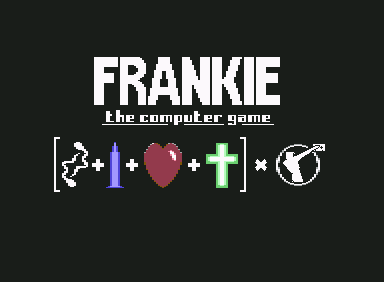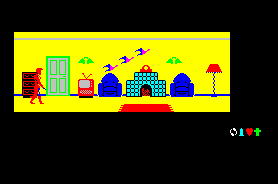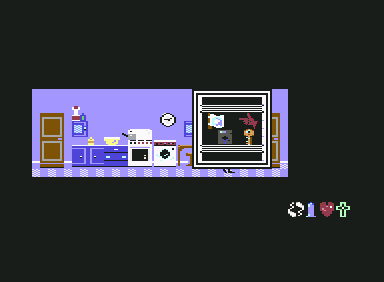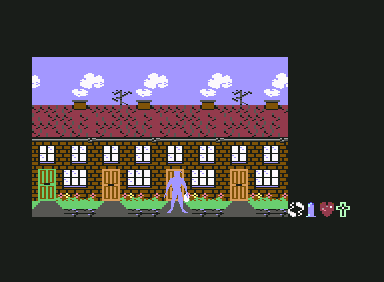The making of Frankie Goes To Hollywood
Welcome to the pleasuredome.
By early 1985, Liverpool pop band Frankie Goes To Hollywood could do no wrong. Having just released the fourth cut from their debut album, Welcome To The Pleasuredome in March, and with a new album incoming, the future of this stylish and overtly sexual group seemed assured. While the world of videogames was grasping the promotional power of riding on another property's coat tails, a game focused on this most idiosyncratic of bands was hardly a natural fit. But that didn't appear to worry Manchester software house Ocean.
At this time, Ocean was still using its favoured developers, Denton Designs, for many of its projects. Forged from the fallout of the collapse of Imagine Software the previous year, Denton Designs was swiftly establishing a reputation for original and inventive games. Everybody knew the band, and working on the Spectrum version was veteran coder John Gibson.
"[Frankie Goes To Hollywood] were famous at the time, so you'd have to have been a Martian not to have heard of them," he says. For Liverpudlian Ally Noble, Gibson's partner on Frankie, there was a bigger empathy for the group. "I'd seen them play at Larks in the Park in 1982," she remembers. "They were the band to see, and I slightly knew two of the members from my old art school days. We also went to the same clubs - I remember dancing with Paul Rutherford at Jody's."

These differing experiences inevitably influenced Gibson's and Noble's reactions upon hearing of the licence. "I thought David Ward [Ocean boss] was mad to want to make a game about a pop band!" exclaims the former. "Especially when the band insisted that the game didn't have its members running around in computer form." Super fan Ally Noble was notably more enthusiastic. "I was up for it immediately and loved the idea. While the others took a while to come round, I was very excited by the potential. I had a special affinity to the band: Liverpool isn't a huge place, so there was a family feeling if you go to the same places."
Denton Designs began group brainstorming, Gibson and Noble on the ZX Spectrum (and latterly, Amstrad), Graham 'Kenny' Everett and Karen Davies the Commodore 64, with Fred Gray on sound duties and Steve Cain overseeing both versions. "We spent a LOT of time discussing and going round in circles with ideas, again and again," recalls Noble. "It was a hard transition, from the music into something concrete, with playability." Help and ideas from Ocean were slim, as Gibson remembers. "It was like, 'Go away and produce a blockbuster game.'"
The ZX Spectrum lead version used an upgrade of the engine that the coder had refined for Gift From The Gods, with Noble also responsible for the graphics in that game. As the team's main fan of the band, she delved deep into the ideas and driving force behind its music and artwork. "The whole band concept was a bit ethereal!" she says. "We brought 12 inch single covers in and looked at everything we could to try and get ideas. We read interviews, and talked to Paul Morley when we met him - he was as enthusiastic, knowledgeable and intense as he was on TV. Karen and I were familiar with the band's output - but it was still a big ask to turn songs into games." It is a testament to the Denton Designs team that what they came up with was not only a fantastic game, but also an admirable interpretation of the band's core passions and ideals. But it was a struggle. "Some of the brainstorming sessions were quite fraught," says Noble. "The programmers needed something concrete to work with and we were all throwing ideas around, which wasn't enough for them to get their teeth into."

Central to the game is the angular figure that first featured on Frankie's debut album, Welcome To The Pleasuredome. This ghost-like figure represents the player, on a quest to become a 'complete' person, and it's achieved by completing 60 tasks, ranging from mundane jobs such as feeding the cat, to solving a murder and taking part in the many mini-games throughout. The score is represented by the four-prong tenets of sex, war, love and religion, progress of which is noted in a bar-chart in the lower right part of the display.
"The shadow character as the hero came up in one of the meetings," explains Noble. "Then it was another step towards building him up out of those attributes, and those being the icons we saw on the LP sleeve." Those four little icons - signifying love (heart), war (bullet), religion (cross) and sex (a cheeky brace of circling sperm) are boosted as the player explores the game. Becoming a real person opens up the door to the ultimate experience: the heart of the Pleasuredome.
Most of Frankie Goes To Hollywood takes place within the world of Mundanesville, a series of bleak northern-themed streets and homes, flying ducks and retro mantelpiece clocks adorning many of the rooms. Roaming around the streets and houses will eventually instigate a mini-game to appear; step inside and the player finds themselves competing in one of Frankie's bizarre arcade sub-elements.
The most memorable of these are a shoot-'em-up called Raid Over Merseyside and Talking Heads, a literal spitting battle between two famous world leaders. After a certain time, the player will stumble upon a dead body - there's been a murder, and the occasional pop-up clue will help them work out who the perpetrator is. Strangely, this fundamental part of Frankie didn't come to be until late in development, as Noble tells. "We had lots of little games that the team had come up with, either singly or in pairs. But we needed a central core to hang all those from, and that was really hard to come up with." Once the idea of a murder mystery was suggested, it became the perfect hook to hang the rest of the game around.

For Ally Noble, being able to draw and design common domestic items was a welcome change from spaceships and laser pistols, and she had a key role in the look of Frankie. "The tiled fireplace and ducks were my favourites, and it was influenced by my love of the 50s - that's where the fireplace came from, and you can't beat a milkman delivering milk - they've come right back in fashion now!"
While it was most probably lost on your average twelve-year-old, Frankie's positioning of the abnormal versus normal - Mundanesville versus the world underneath of weird mini-games and the Pleasuredome - is exceptional in an 8-bit game. "I think the strange is always bubbling under the mundane - you just need to look for it, and once you see the detail, you can understand the unusual." Also uncommon in an era where computer games were still strictly perceived as 'for kids', was the political comment infused in the game such as the murder clue, 'Joe Public has always voted Tory'. "I think a few of us were quite political, and people did have strong allegiances back then," says Noble. Politics and music were closely aligned in the 80s with the Rock Against Racism and Red Wedge movements - it was natural that any game based on a band such as Frankie Goes To Hollywood include some degree of political message. "Plus Liverpool has always been a political city," notes Noble. "You couldn't be in Liverpool and not feel strongly during the Thatcher years!"
While the gameplay elements and its compelling gameplay would endear Frankie to audiences and reviewers upon release, the way it's presented impressed most in the early days of development. Using the Gift From The Gods engine as a base, Gibson worked on improving its scope for Frankie. "At Imagine, Ian Hetherington had an Apple Lisa computer with an operating system that used windows. I thought it would be cool if I could implement that on a Spectrum game, so had already begun work on it before Frankie." Gibson's familiarity with his veteran engine - it had also been used on Imagine's Zzoom and the ill-fated megagame, Bandersnatch - ensured maximum time and effort went into expanding it for his latest game. "The only potential problem was overloading the renderer. It's why the play area couldn't be any bigger," he notes.

Even today, the end result is exceptional, and a prime example of how the 80s often produced a brand of video game that, uncluttered by marketing or outside influences, was completely fresh and novel. "Frankie Goes To Hollywood didn't just produce music," says Gibson. "They had a philosophy, and the game revolved around that philosophy. Plus, the games industry was looking for a more mature audience at the time, and Frankie was aimed at them - but it was still a fun game that youngsters could enjoy." Did Ally Noble, a Frankie fan at heart, feel it was a suitable tribute to the band? "Yes, once the elements fell into place," she replies. "I do think its sum is greater than the parts, and it was a true collaboration of ideas. I think we produced something esoteric and cool, and something that matched the band."
With perhaps half an eye on the band's own impressive album and single covers, Ocean commissioned a beautiful rectangular card box for Frankie with an impressive Bob Wakelin image of the band. The extra space inside was used to hold a second tape - on it was a slightly different version of the band's biggest hit, Relax. "When we did the Frankie Goes To Hollywood game, we got the group to give us a version of the song Relax," said David Ward in the excellent Fusion Retro Books publication, The History Of Ocean. This tweaked version of the song ensured that the Manchester software house didn't have to cough up extra for any more rights, and there was even a brief hope of presenting all of its releases with a separate music track.
Ocean's Frankie Goes To Hollywood didn't need Relax, but it helped. The game scored uniformly high when released in the late summer of 1985, a 97% total score in the parsimonious pages of Zzap! magazine a particular highlight. For Denton Designs, like the band, the heights of 1984 and 1985 would rarely be hit again. "It was a golden age of Denton's actually," says Noble wistfully. "As a group we made some great games together, had tough times and a lot of fun. Every day was an exciting challenge making something you didn't know how to make, solving problems, working together with friends and sharing the highs and lows. It was a happy time, with great people." By 1987, only Noble was remaining of Denton's founders and Frankie Goes To Hollywood was no more, a victim of difficult second album syndrome and musical differences. They may both be gone, yet 35 years ago, these two groups combined to produce a gaming oddity that brings together politics, humour, mystery and fun in a distinctly 80s piece of software. Welcome to the Pleasuredome.









